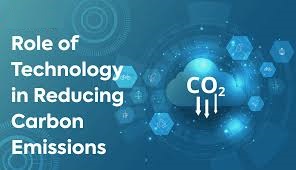In recent years, the push to reduce carbon emissions has gained unprecedented momentum, fueled by growing concerns about climate change and its impact on our planet. Governments, businesses, and individuals are striving to adopt more sustainable practices, and technology is playing a pivotal role in making these efforts effective and measurable. From innovative tools like carbon footprint calculators to advanced solutions for energy efficiency, technology is enabling us to combat climate change more effectively than ever before.
In this blog, we’ll explore how technology is driving carbon emissions reduction, focusing on key strategies such as leveraging carbon offsets, improving energy efficiency, and enhancing corporate sustainability initiatives through frameworks like the ESG (Environmental, Social, and Governance) framework.
1. The Power of Technology in Measuring Carbon Emissions
A critical first step in reducing carbon emissions is understanding where they come from. Technology has enabled the creation of tools like carbon footprint calculators, which allow organizations and individuals to measure their greenhouse gas emissions. These tools provide valuable data that can inform actionable strategies to reduce emissions.
For instance, businesses use these calculators to identify their most significant emission sources, such as transportation, energy consumption, or supply chain operations. Armed with this information, they can take targeted actions to reduce their carbon footprint, such as adopting cleaner energy sources or optimizing logistics.
Beyond individual tools, technological advancements are also driving more sophisticated reporting systems. For example, frameworks like ESG reporting and GRI (Global Reporting Initiative) standards are helping organizations track and disclose their environmental impact more transparently. By integrating digital tools into these frameworks, companies can easily gather data, assess their sustainability performance, and set clear goals for emissions reduction.
2. Energy Efficiency: A Game Changer in Carbon Reduction
Technology is also transforming the way we consume energy, making efficiency a cornerstone of carbon emissions reduction. Smart grids, IoT (Internet of Things) devices, and energy-efficient systems are enabling businesses and households to optimize energy usage and reduce wastage.
Take smart buildings as an example. By using IoT sensors and energy management systems, businesses can monitor real-time energy consumption and identify inefficiencies. These systems automatically adjust lighting, heating, and cooling based on occupancy and weather conditions, significantly reducing energy usage and emissions.
On a larger scale, energy-efficient technologies are being deployed in industrial processes, where emissions are often the highest. Advanced machinery, AI-driven optimization, and renewable energy integrations are helping industries cut emissions while maintaining productivity. By prioritizing energy efficiency, companies can not only reduce their carbon footprint but also achieve significant cost savings—creating a win-win scenario.
3. Carbon Offsets and the Role of Technology
While reducing direct emissions is critical, some emissions are unavoidable. This is where carbon offsets come into play. Carbon offsets allow businesses and individuals to compensate for their emissions by investing in projects that remove or reduce greenhouse gases from the atmosphere, such as reforestation, renewable energy initiatives, or carbon capture technology.
Technology has made it easier to participate in and track the impact of carbon offset programs. Digital platforms now allow companies to seamlessly invest in verified offset projects while ensuring transparency and accountability. Blockchain technology, for example, is being used to create immutable records of carbon offset transactions, ensuring that funds are being utilized effectively.
Additionally, advancements in satellite technology and AI are enhancing the monitoring of offset projects. For example, satellites can track the health of reforestation efforts in real time, providing accurate data to ensure these projects are delivering the promised environmental benefits.
4. Corporate Sustainability: Aided by ESG Frameworks
Technology is also revolutionizing corporate sustainability efforts. The ESG framework has emerged as a powerful tool for businesses to align their operations with environmental and social goals. By leveraging technology, companies can automate ESG data collection, analyze trends, and generate comprehensive sustainability reports.
For example, digital tools powered by AI and big data can identify sustainability risks across supply chains, allowing businesses to address them proactively. Similarly, technology is enabling companies to communicate their sustainability efforts to stakeholders effectively, enhancing transparency and building trust.
The integration of technology into ESG frameworks is also driving innovation. Businesses are now exploring emerging technologies like AI, blockchain, and machine learning to tackle challenges such as waste management, resource optimization, and emissions reduction. By embracing these technologies, organizations can take meaningful steps toward reducing their carbon emissions while staying competitive in an increasingly eco-conscious marketplace.
A Collaborative Path Forward
While technology is undoubtedly a powerful tool in the fight against climate change, its true potential lies in collaboration. Governments, businesses, and individuals must work together to maximize the impact of these innovations. From adopting energy-efficient solutions to supporting carbon offset initiatives, every action counts.
Moreover, frameworks like ESG and GRI standards are helping to bridge the gap between corporate responsibility and environmental sustainability. By combining the power of technology with clear reporting guidelines, businesses can lead the charge in reducing emissions and inspiring others to follow suit.
Conclusion
Technology has become an indispensable ally in the global effort to reduce carbon emissions. From tools that measure our impact, such as carbon footprint calculators, to solutions that enhance energy efficiency and enable carbon offsets, innovation is paving the way for a more sustainable future.
As we continue to embrace technological advancements, it’s essential to remain committed to climate action. By integrating these technologies into corporate sustainability strategies and leveraging frameworks like ESG, we can make meaningful progress in combating climate change and building a better world for future generations.
The road ahead requires collaboration, creativity, and a shared vision of a sustainable environment. With technology as our guide, achieving significant carbon emissions reduction is no longer just a dream—it’s a reality within our grasp.


